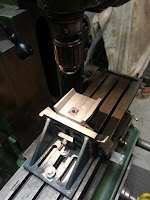Once we had the capacity to lock down the steady rest completed we went on to milling out the slots where the bronze fingers would ride. This was an other operation that did not quite do according to plan. When I made the moulds used for the casting I am quite sure that I carefully laid out the three finger locations to be exactly 120deg apart. However as you'll see later on the three slots are not quite 120 deg apart. I should have relaid out the spacing before milling however I trusted the casting to be correct when it wasn't. Oh well not a game changer we'll work with it however I'll be a little more careful on other projects. So in order to mill out the slots I first milled a groove at 90deg to the slot layout at the top end of the slot where the adjusting bolt will go through. Once that was done we centred up a cutter on the slot area and but out the slot. I made three passes to get to final depth and then moved the cutter over a little to make one final pass to get the correct width. I ended up making the slots .800" wide which I feel left just enough material on either side to keep it's strength. Here are some photo's showing the operations.
After I had the slots done decided it was time to make up the locking clamp that goes on the side opposite the hinge. This is essentially a U shaped device with a pin through the lower section and a threaded bolt going through the top of the U that clamps against the top section. The U was made from three pieces of steel that I tig welded together. After they had cooled I ground down the weld and rounded some corners before locating it on the lower section and drilling the hole through all three pieces that would hold the securing pin. I then drilled and tapped a hole at the top for the lock down bolt. I handmade the bolt on the lathe using some hex stock that I had. I initially was going to just use a 1/4" bolt and nut as the securing pin however I might just make up a steel rivet just like I did for the hinge pin.
Now that this was done we could get onto milling out the bronze for the fingers. I cut a piece long enough for three fingers and placed it on the mill. After a little bit of time the piece was the correct width and thickness for the slots I had machined. I then cut the bar into the three fingers and spent some time giving the one end a slight roundover. I then marked out the centre and drilled and machined out the slot through which the locking bolt will go. This slot was cut out to 3/8" wide. Here are some photos showing the milling of the three fingers and the last photo shows them laying in the steady rest.
Now we went onto machining a nut and bolt to hold these fingers on the steady rest. Again I made the first bolt and then realized I had no way of securing the bolt as the bolt had a rounded head and I forgot to make the shaft larger enough to mill some shoulders on it that would lock in the slot of the finger. So we had to redesign the bolt and then proceed to make three of them. The nuts were just made from hex stock I had lying around. Here are some pictures showing the bolts under construction and then the pieces lying beside a finger, as well as some pictures showing them installed. First picture is the "mistake" bolt
Once that was done I drilled and tapped a hole in the casting at the end of each finger slot to accept a 5/16" threaded bolt I would make. On this one I decided to make a square bolt head that matched a few of the square bolts on the lathe so I could use the lathe wrench to tighten these bolts. To machine the 4 sides of the bolt head I turned to my Milling machine and its dividing head. Here are some photo's showing the machining and the final installation.
So now I need to decide what colour to paint it and then once that's done oil up the remaining surfaces and place it on the lathe for future use. I also still need to machine the fingers and their accompanying nuts and bolts for the second steady rest however there is no rush as that lathe still is not completely working yet either.
So that's all for now hopefully down the road I'll have more writeups as we complete working on the lathe and possibly start some rebuilding on the Van Norman Milling machine as well.
All the best and see you in the future.
Harold















































